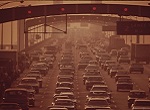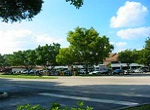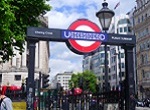Confronting the Causes of Urban Sprawl
Last Updated: May 22, 2024
Causes of urban sprawl include:
- Consumer and real estate industry preference for large houses and large lawns
- Dislike of housing "density" by a vocal and often uninformed minority that equates density with public housing, undesirable apartment complexes and rental tenants, and traffic and noise
- Lack of understanding of, or ignoring the consequences of, unplanned growth of metropolitan areas, smaller cities, and towns, or sometimes lack of an effective structure of regional governance to deal with these questions and to prevent individual little suburbs from competing to build redundant shopping opportunities
- Allowing commercial strip development along major roads, instead of requiring concentration of retail uses in centers at intersections
- Over-dependence on the automobile as a means of transportation, sometimes necessitated by street layout
- Competition among suburbs for attractive sales tax or property tax generators, sometimes resulting in businesses abandoning one location in favor of another further away from the center of the city
- Giving developers too much freedom to do as they please, underpaying for the public cost of infrastructure as they go
- Outright racism as businesses and residents attempt to flee from the central city, which they perceive to be too dominated by Black and Brown people
- Simple benign neglect on the part of municipal governments, the regional Metropolitan Planning Organization (MPO) that plans transportation investments requiring federal dollars, and business associations and school districts that should know better.
Our experience as planners has been that different metropolitan areas each exhibit a unique mix of these factors, but we have yet to work in metros where all nine of these causes are not in play to some extent.
In some cities, a shortage of moderately priced and low-cost housing encourages buyers to look further and further out into suburbs and rural areas. Some places have such high real estate taxes and housing prices toward the center of the city that lower-cost alternatives in suburban areas are needed to match income capabilities.

Sometimes building, zoning, and historic regulations become so burdensome that many consumers with a more libertarian streak will look outside the city limits. In still other cases, the reality or the perception of high crime rates and a high incidence of nuisance properties and behaviors drive individuals and households to seek peace and quiet in what they perceive to be a more idyllic location.
Demand for Larger Houses
A key point is that the square footage in a typical new home has grown enormously since World War II. The recent round of really big new homes reflect the wish for luxurious master bedroom suites, large closets, "get away" space for the man of the house, extra bathrooms, home theaters or exercise rooms, and a great room adjacent to the kitchen in addition to the formal living room. There's also the desire for three- and four-car garages.
Some of you will object that recently tiny houses have become trendy, but we see that little blip on the screen rapidly fading.
This general demand for a large quantity of very big houses led to new developments, often on the periphery of the urbanized area. New subdivisions often aggravate the causes of urban sprawl further by inspiring a similar project from competitors.
Our unwillingness to put up with the decision-making and trade-offs required for housing renovation to current tastes, coupled with the lack of patience to wait a few months while this rehabilitation occurs, has made new housing feel essential to many families.
It's as if we want to substitute more privacy from each other in the family, and more privacy from neighbors, for the hard work of relating to and getting along with other people in a community.
Maybe one of the causes of urban sprawl is that we aren't mastering interpersonal communication and tolerance for diversity. We say this only partly in jest.
How Individual Actions Undermine Smart Growth
We meet many people who just don't seem to understand (or care) that the new housing they want means a real blow to their old neighborhood. Or if their old neighborhood still experiences good demand, there's another neighborhood nearby that people are leaving because of the construction of the new house. That's providing that overall demand in the metropolitan area remains stagnant.
On this website, we're willing to admit that the urbanized area could expand proportionately in the event of population growth. So in areas that actually are attracting new residents, new housing can be built. Care should be taken to assure that the inner core and inner suburbs are in terrific repair and current for today's market before allowing growth at the periphery.
Developers create housing because that's what they do, and it's easiest to make a predictable profit when starting with a blank slate. Of course another part of the puzzle is that often neighbor opposition makes development at a profitable density nearly impossible in the already-built-up parts of the city. So without venturing over too much into a discussion of the solutions to urban sprawl right here, let's say that a YIMBY (yes, in my back yard) movement equal in strength of the various NIMBY (not in my back yard) movements is important.
So a cause of sprawl is a government too that's too spineless to say, "We don't need any more new housing right now. What we need is for the building trades to embrace housing rehabilitation, recycling older buildings to meet the demands and needs of today's families."
That's easier said than done in most metropolitan areas, simply because of governmental fragmentation. If there are many suburbs with separate governments, plus a central city with no power over its suburbs' land use planning decisions, the negatively affected governments can't regulate the area where the problem lies!
So this is why we say the causes of urban sprawl are a regional governance issue, and one to be tackled by both governments and activists at the regional level.
Inefficient Regional Shopping and Employment Centers
A severe regional problem aggravating the causes of urban sprawl is the lack of coordination in many cities about where major shopping districts and employment centers may be placed. Shopping malls tend to compete to be the newest and therefore the one with the most buzz, without regard to whether the next closest center will be forced into a major slump.
The formula is to request public subsidy in the form of tax increment financing or whatever is popular in your area, remodel, bring in a few stores that haven't been seen in the area before, make some stores more glamorous and outrageously pro-consumption, sponsor a huge media blitz, and try to dominate for a few years.
Then let things run on auto-pilot until it begins to look dowdy again, until the tax code changes in a way that is advantageous, or until someone does the same thing to you that you did to the adjacent mall.
The fact is that very few metropolitan regions and states exert any control over this shopping center redevelopment process whatsoever, and in fact the state highway departments usually fall all over themselves trying to accommodate the extra traffic, providing the new mall subsidizes those improvements.
The same thing happens on a less glitzy basis in terms of employment centers. Office towers and complexes too are in fierce competition with one another, and try to outdo one another in glass frontage, immaculate landscaping but minimal natural landscape, and proximity to appropriate restaurants.
But there is no provision for whether the construction of a new complex will steal enough tenants from the older one nearby to make the older office buildings start to become a community problem and eventually face excess vacancy.
Builders argue this is democracy, about 98% of the citizens think this is "just the way things are," and a small number of us are left to scratch our heads and ask why this kind of thing is allowed to go on.
Just as with residential development, we think it isn't a substantial inhibition of a developer's freedom to suggest that he has to rehabilitate older office buildings rather than build new ones.
Merely because rehab is more of a challenge, there is no reason to think it's somehow inferior to new construction.
The argument frequently is made that new construction is actually less costly than rehabilitation. That depends widely on conditions, of course, but let's just say that it's true in a particular situation.
The problem with this logic is that it isn't taking into account the public sector and utility costs, as well as the private transportation costs over the life cycle of the building. If those items were accounted for, we would see that it's way too expensive to build new buildings on the edge of the urban area!
Or to say it another way, one of the causes of urban sprawl is that we don't really want to look at the effects of urban sprawl.
When We Don't Want to Live in Community
It's time to be serious about the fact that some of us just want to bowl alone, as the Robert Bellah book title would have it. We really want to live like we're in the country, where we can do what we please, but we want to have all the amenities an urban salary can bring us.
So if you're really a country person wanting to earn an urban income, what you do is find yourself a single-family home on as large a lot as you can afford, fence that three-acre lot off from everyone, and come home every night, park the SUV in the garage, and refuse to be neighborly. That's one of the sociological causes of urban sprawl, don't you think?
A similar related factor may be simple racism. Where I live, it's alive and well. We want to get the heck as far away from where there are very many people of a different color.
Since race still is associated with poverty in the U.S., part of it just may be anti-poverty prejudice as well. Nevertheless, white flight has been among the causes of urban sprawl, I'm afraid.
Why Can't We Have Smart Growth?
This summary of the causes of urban sprawl should be short and sweet, because just a few reasons account for the apparent popularity of sprawl:
1. Changing tastes in housing, shopping areas, and employment centers lead people to the erroneous simplistic conclusion that building new will be less expensive than recycling existing buildings to meet current needs.
2. In most urban areas, no single governmental entity, public interest private group, or coalition is strong enough to stand up to real estate developers to tell them that they are not allowed to build a new housing development, shopping center, or employment center until all existing housing has been refurbished to meet today's needs and is occupied.
3. We don't want to be around people who are different, ethnically, sociologically, or economically. We are sorting ourselves into geographic groupings of sameness to a degree unprecedented in U.S. history.
We can't address these causes of urban sprawl successfully until we have a great public educational campaign and outstanding coalition building, as detailed in urban sprawl solutions page.
Read More To Deepen Understanding About This Issue
- Making and Keeping a Good Community >
- Community Challenges, Common Topics & Concepts >
- Urban Sprawl > Causes of Urban Sprawl
Join GOOD COMMUNITY PLUS, which provides you monthly with short features or tips about timely topics for neighborhoods, towns and cities, community organizations, and rural or small town environments. Unsubscribe any time. Give it a try.



